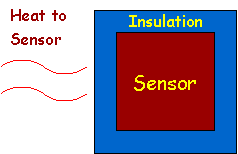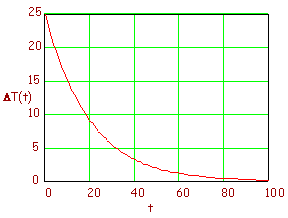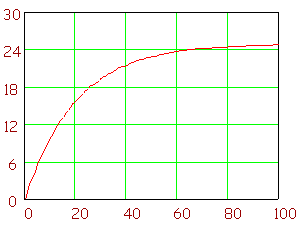| Sensors - An Introduction |
An Introduction to Sensor
Dynamics
Temperature sensors are often sensing devices embedded within some sort of
insulation. The insulation may often be for electrical purposes - to
isolate the sensor electrically. However, good electrical insulation is
often also good thermal insulation, and the presence of that insulation causes
the sensor to respond tardily when the sensor heats up.
We'll
try to put together a simple model to help explain that behavior. When we
say explain, we mean to imply that we are looking for a mathematical model
for a mathematical explanation. We start with a physical model - the
one shown below.

In this model, we assume the following.
-
The sensor is embedded within a
layer of insulation that insulates the sensor from the heat source that the
sensor is supposed to experience.
-
We assume that the temperature of
the sensor is Ts(t) - and it is going to be a function of time
because we want to see how it changes in time when the applied temperature
changes.
-
We represent the external
temperature with Ta(t).
-
We assume that the heat flow into
the sensor from the outside is given by:
-
Heat Flow To Sensor = [Ta(t).
- Ts(t)]/Rth
-
In other words, the heat flow to
the sensor depends upon the difference between the external temperature and the
sensor temperature, and the heat flow gets less as the thermal resistance
between the sensor and the external temperature becomes higher (better
insulation).
-
We assume that a given amount of
heat raises the temperature of the sensor by an amount proportional to the
amount of heat. In other words, the temperature of the sensor is
proportional to the amount of heat energy it contains.
-
Then, we can write an equation
that relates the heat content of the sensor to the flow of heat into the sensor.
Unfortunately, this is going to be a differential equation.
-
In this situation, a little
re-definition of variables will produce a differential equation that is a lot
easier to solve.
-
Define:
DT(t) = [Ta(t). - Ts(t)]
-
If the surrounding temperature, Ta(t),
is constant, then dDT(t)/dt = - dTs(t)/dt, and
-
dDT(t)/dt = - dTs(t)/dt = -[Ta(t). - Ts(t)]/RthCs
= DT(t)/tth , and this can be rewritten as:
-
dDT(t)/dt = -DT(t)/RthCs
= -DT(t)/tth
-
Now, our goal is to take this
differential equation description and use it to get a meaningful description of
how the sensor responds.
There are a few special situations that we will examine here. That won't
get us to a general description that would allow us to predict what would happen
in every situation, but that's what the differential equation is for. Here
we will solve the differential equation for a few special cases in order to get
an appreciation of what the time behavior of the sensor is. The situations
we will examine are:
-
The case where the temperature of
the surroundings changes suddenly and has to come to equilibrium at the new
temperature.
-
The case where the sensor is taken
from a temperature then put into new surroundings and allowed to cool (or rise?)
to the temperature of the surroundings.
However, it does not matter which
of those situations we have. In either case, the differential equation and
the solution to the differential equation is the same. We will find that
the only thing that matters is the initial temperature of the sensor, and the
final temperature it achieves - the temperature of its' surroundings.
Imagine that the sensor is taken from a temperature and has to come to
equilibrium with new surroundings. Imagine a situation where the sensor is
at a high temperature and is removed to a cooler temperature. The
differential equation we derived above still holds, and we can solve it here.
Let's look at that differential equation again.
This time function will look like the following plot.

This plot is done for the following parameters:
-
DT(0) = 25 degrees
-
tth= 20 seconds
Points to note on this plot include the following.
-
The temperature difference,
DT(t),
asymptotically goes to zero as time gets large.
-
Since the time constant for the
example was 20 seconds, it seems as though it takes about five (5) time
constants (100 seconds on the plot) for the response to decay to the point where
you can safely say that it has reached steady state - even though that steady
state is only approached and never reached theoretically.
If we have a
situation there the sensor finds itself in a surrounding temperature higher than
its' current temperature, then the sensor temperature will have to rise.
In that situation, we have a plot like the one below.

This plot is done for the same parameters as above,
except that the actual temperature is plotted here. If you get a plot like
this - in lab, for example - you will need to extract the temperature
difference. Here the steady state looks to be 25 - starting from 0 - and
the temperature difference - that decays to zero - is obtained by subtracting
the actual temperature from 25 degrees.
|

